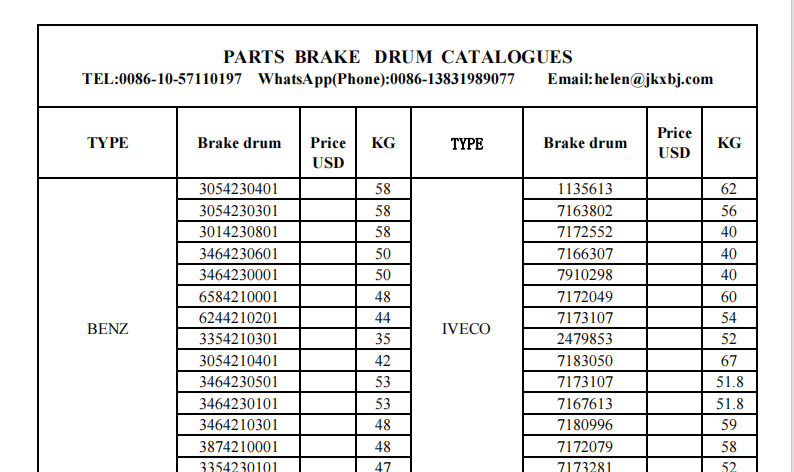Dec . 29, 2024 17:54 Back to list
remove brake drum
Understanding the Process of Removing Brake Drums
Brake drums are a crucial component of the braking system found in many vehicles, especially in older models. They play an essential role in slowing down and stopping the vehicle by generating friction against the brake shoes. Over time, brake drums may wear out or become warped, necessitating their removal and replacement. In this article, we will thoroughly explore the process of removing brake drums, highlighting the tools needed, safety precautions to take, and the step-by-step procedure.
Tools and Equipment Needed
Before diving into the removal process, it's essential to gather the necessary tools and equipment. Here’s a list of items you'll typically need
1. Jack and Jack Stands To lift the vehicle securely. 2. Lug Wrench For loosening wheel nuts. 3. Brake Drum Puller A specialized tool that helps in removing stubborn brake drums. 4. Wrenches and Sockets To remove various bolts and nuts. 5. Safety Goggles To protect your eyes from debris. 6. Gloves To keep your hands clean and protected. 7. Brake Cleaner For cleaning parts before reassembly.
Safety Precautions
Working on your vehicle can be dangerous if proper safety precautions are not followed. Here are some essential tips to ensure your safety while removing brake drums
- Work on a Level Surface Always perform maintenance on a flat surface to prevent the vehicle from rolling. - Engage the Parking Brake This keeps the vehicle from moving unexpectedly. - Use Jack Stands Never rely solely on a hydraulic jack to support the vehicle; always use jack stands for added safety. - Wear Protective Gear Use gloves and eye protection to guard against dirt and debris.
Step-by-Step Process of Removing Brake Drums
1. Loosen the Wheel Nuts Begin by loosening the lug nuts on the wheel where you will be replacing the brake drum. It’s easier to do this while the wheel is still on the ground.
2. Lift the Vehicle Use the jack to lift the vehicle until the wheel is off the ground. Secure the vehicle with jack stands to ensure it remains stable while you work.
remove brake drum

3. Remove the Wheel Once the vehicle is secure on jack stands, remove the lug nuts completely and take off the wheel to expose the brake components.
4. Inspect the Brake Assembly Before removing the brake drum, inspect the brake shoes and other components for wear and tear. This will give you an idea of whether any additional parts need replacement.
5. Remove the Brake Drum If the drum is easily accessible, try to pull it off by hand. If it’s stuck, use a brake drum puller. Attach the puller to the drum following the manufacturer's instructions and turn the handle to apply even pressure until the drum dislodges.
6. Inspect the Brake Drum and Shoes Once removed, carefully inspect the drum for any signs of damage, such as cracks or deep grooves. Similarly, examine the brake shoes for wear. Measure the thickness of the shoes and compare it with the manufacturer’s specifications.
7. Clean and Prepare for Reassembly Clean the drum and the brake assembly with brake cleaner to remove dust and debris. If you're replacing the drum, ensure that the new one is ready for installation.
8. Reinstall New or Repaired Parts If the drum was damaged, install the new or refurbished drum onto the hub. Ensure that it fits snugly and rotates freely.
9. Reinstall the Wheel Before lowering the vehicle, put the wheel back on and hand-tighten the lug nuts in a star pattern to ensure even tightening.
10. Lower the Vehicle Carefully remove the jack stands and lower the vehicle back to the ground.
11. Final Checks Once the vehicle is back on the ground, use the lug wrench to securely tighten the lug nuts. It’s advisable to recheck everything after a short test drive.
Conclusion
Removing brake drums may seem daunting, but with the right tools, safety precautions, and a step-by-step approach, it can be a manageable task for anyone willing to engage in vehicle maintenance. Always remember that safety comes first. If you’re unsure of any steps, it’s best to consult a professional mechanic. Proper brake maintenance not only enhances vehicle performance but also ensures the safety of all road users.
-
Volvo Brake Drum: OEM Quality, Optimal Safety
NewsAug.27,2025
-
Durable Brake Drum MAZ for Heavy Duty Trucks | High Performance
NewsAug.26,2025
-
FUWA: Premium Quality, Reliable Performance & Innovative Solutions
NewsAug.25,2025
-
Liza Brake Drum: Superior Quality & Performance for Safe Driving
NewsAug.24,2025
-
Iveco Brake Drum | Premium OE Quality for Daily & Eurocargo
NewsAug.22,2025
-
Your Brake Drum Man: Quality & Performance Parts
NewsAug.21,2025
